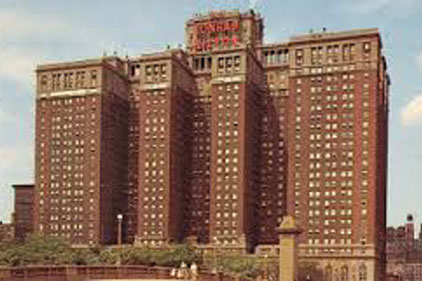To highlight just a few show-related changes, you might find it interesting to know that “back in the day” the show was held in Chicago every year. I believe it was in ’85 it started moving around the country, starting in New Orleans.
Further, rather than McCormick Place, the exhibits were primarily in the Conrad Hilton with the overflow across the street in the Blackstone Hotel.
The show was pretty much self-contained at the Hilton with most of the receptions on the upper floors. As the exhibits closed there was mass confusion at the few (slow!) elevators as literally hundreds of people lined up to get back to their room or reception.
It was not uncommon to see floating craps games pop up at the end of a corridor with some significant money changing hands.
Also, all the exhibitors and most attendees wore coats and ties as opposed to the business casual look of today.
A new world
By comparison to today’s colorful, fashionable safety products, the PPE in those days was pretty boring; black or gray eyewear frames with 48 mm glass lenses as a prime example. The use of polycarbonate and stylish frames was 10-12 years off.
Among early memories is Charlie Leight, founder of Howard Leight Company, demonstrating his new disposable ear plugs by repeatedly banging a couple blocks together. Drove most of us nuts but worked out pretty well for Charlie and his company!
Another memory is the Edward brothers of the Kedman Company wearing great masks around the exhibit hall when the show ran on Halloween as it frequently did.
Mention of these companies leads me to reflect on probably the largest difference throughout the years; i.e. the make-up of the exhibitors.
In the early days of the industry manufacturers and distributors were predominantly family-owned, privately-held businesses. The Norton Company, which I joined in ’75, was one of the early public companies to consolidate the industry through acquisition. After several iterations, that company is now part of Honeywell.
Technology transforms the market
Over time that trend has accelerated and includes distributors as well as manufacturers. Today, large corporate entities dominate both sides of the channel. And of course the number of foreign companies entering the market has also grown dramatically.
While on the subject of change, the way products are marketed and sold today is vastly different as is the way we communicate.
Not only wasn’t there Facebook, LinkedIn or Twitter to promote your products, Al Gore had not yet invented the internet and cell phones were yet to come. Sales reps had to know the location of the best pay phones rather than which coffee shop has best the wi-fi connection.
Sales and expense reports were filled out on three-part carbon paper and mailed to headquarters. CRM and sales force automation tools were on the distant horizon.
Implementing change of course necessitates effective communication which leads me to another event I recently attended.
Are you listening?
A few weeks ago I was invited to participate in a Listening Symposium sponsored by the Donald W. Reynolds Journalism Institute, a state-of-the-art facility based at the Missouri School of Journalism.
The symposium brought together business consultants, lawyers, police, social workers, educators, sociologists, journalists and more.
I had no idea 35 people could spend 36 hours talking about listening!
As I reflect on the pace of change within the safety industry and some of the discussions at the symposium, there are a couple points worthy of consideration in the context of business and change.
1. Our fast-paced, digital world creates a lot of distractions that hamper effective listening
2. Effective listening requires a clear message from the speaker
As companies continue to make acquisitions, enter new markets, consider new products or change the way they do business, it is important their message is clear to internal, as well as external, constituents.
Companies talk about VOC (Voice of Customer) programs but do they truly listen? Many might talk about the importance of VOC but, dare I say, only pay it “lip service.”
Because poor listening (communication) can lead to poor decisions, it behooves us to remember Edward Deming’s formula for the costs of poor decisions:
$10 to rectify at info gathering
$100 to rectify when the decision is made
$1000 to rectify when the decision is executed
No amount will rectify when the results of the decision get into the hands of customers.
Time to turn the page
So, whether making a sales call, interviewing a prospective new hire or considering new strategic initiatives, effective listening is critical to the process.
As this is a time for some personal reflection, I will take the last word. After 17 years of writing this column, this will be my last.
I have truly enjoyed sharing my thoughts on a variety of industry-related topics and appreciate the opportunity that ISHN and Dave Johnson have given me to do so.
I have also appreciated your feedback throughout the years.
So while we will continue with our business and remain a part of the safety industry, I thought it was time to turn the space over to someone else to share their views.
Here’s wishing you great success in dealing with the inevitable changes that will confront your business in the future.
Editor’s Note: Thank you, Herb!


